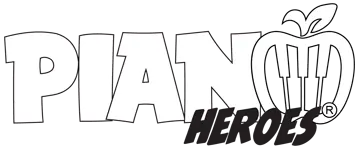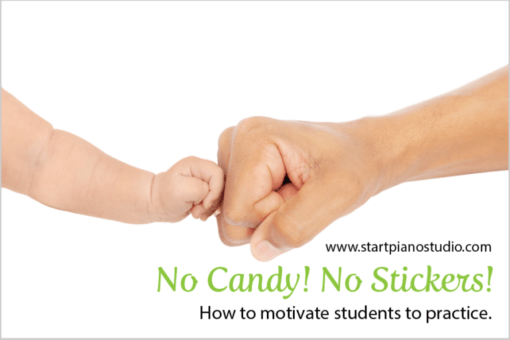What is practicing?
Studying and practicing are often looked at as memorization and drilling, which are performed over and over again until the information is seared into the brain. However, for most, memorization is an inefficient and stressful path to understanding and capability. Many studies have been conducted about piano and practice in general, and as expected the same, foolproof strategies that have been used throughout history proved to be the most efficient. So, perhaps it is time to re-invest in practice by looking back.
What we shouldn’t do in consideration of practicing music
Like many negotiations, you must give to get. As many teachers and parents may know, kids expect something in return for practicing. Whether that’s time on technology, stickers or candy. Understandably, that is neither the positive nor easy method in the studio and even at home. Both candy, stickers and tech time have their own negative impacts. Moreover, using small favours to compensate for practice can negatively impact the student’s education habits. Not to mention their mental and physical health in various ways (see dopamine drip). Let me give you a very sad example of how one of my very good students almost blew away the RCM exam. Since she was promised by her parents some kind of bonus after good practice at home and in the lesson, she started becoming frustrated with every mistake she did in the lesson. It grew to terrifying tantrums by shouting between her and her mother right at the lessons. Eventually, every single lesson has become unbearable stress for all. We do not want some students to only play for the rewards and not in pursuit of higher musical education.
What we can do to improve musical practice
On the other hand, there are many things that teachers, parents, and students can change to ensure that practice is beneficial to the student and their musical education. To guarantee this, we must first understand that learning and repeating something over and over again, are two very different things. Learning is finding a path for each student that conforms to their abilities, wants and needs. Fortunately for us, there are strategies that we can copy, learn from and improve to help our students become successful musicians.
In the Lesson
Children are naturally curious and love games, this characteristic often sparks interest in an instrument. And as such, is a flawless strategy for any teacher. The piano isn’t any different and it would serve you best to make your lessons fun, and fill them with engaging and fun activities. Establish a practicing routine. Every lesson should include warm-ups/technique exercises, review/mastering of the learned pieces and learning of new material.
Warm-ups/technique exercises
Finger games and warm-ups, scales and etudes should be an essential part of every lesson, starting from the very first meeting.
Review/mastering
That’s when the learning of the proper practice is introduced. Teach the student to identify the problem, help to figure out what might cause it (wrong fingers, misplaced note, technically challenging passage) and then fix the problem by isolating a small portion and practicing it.
Learning of the new piece
Working on the challenging part of the piece should be a priority instead of playing 5 times from the beginning to the end. Always make small and attainable practice goals and write them down in the student’s planner: “learn a passage in m.7 RH”, “smooth out a scale in the LH mm.6-8”. This strategy will help to learn musical pieces faster and more efficiently.
Practice away from the piano
Some of the practicings can be done away from the piano. Listening to the recording for analyzing the dynamics, and phrasing, getting to know the character of the piece, beating the rhythm, and mapping the piece for better and faster memorizing.
Organize and plan
Always plan the phases of learning and working on the piece before starting. For example, follow this sequence; spend 3 lessons on text, fingering, and playing with both hands together, then 3 lessons for memorizing and working on the phrasing, finishing with 6 lessons on mastering artistry. This strategy will help older students take control of their learning and to help younger students beware of the next steps.
At Home
Practice Environment
Children today live in a world full of distractions. It is important to create an environment that will allow your child to focus on the practice for a period of time without interruptions. Your piano should be located in a quiet area of your home.
Practice Time and Length
Consistency is the key to mastering the piano. Arrange your child’s schedule in such a way that they can practice every day for 15 to 40 minutes. The length of time will vary depending on the level your child has mastered and their age. Practicing every day at the same time will help to develop good practice habits. Never set a specific amount of time for practice. The “30 Minutes Rule” never works. Instead, set specific goals for each practice session and allow your child to take a 5-minute break if they are having trouble concentrating.
Practice Organization
Set goals on daily, weekly and long-term goals for your child. For example, a goal for today’s practice can be to master the D Minor scale and arpeggio and to learn 4 measures of Sonatina with right fingering. I will give your child homework on a weekly basis. Ensure that time is allotted throughout the week to finish the homework before your child’s next lesson. I will mark any area of difficulty your child is having on the sheet music provided. Have your child work on these sections before their next lesson. It is important to master every section before moving on to another piece.
Practice Quality
Quality practice time is better than hours of practice in the end. It’s not about how long you practice, but about how well you practice. Stop practicing before it becomes a war of wills. Come back when your child is ready to continue. Establishing a practicing routine is not an easy task, but very important for piano playing development. Modifying these ideas of studying, teachers and parents can look at practicing as something that matters in quality, not quantity. Something, that will lead to satisfying accomplishments in the future. It is time to reinvent practice, so it finally becomes what everyone deems it to be. Don’t forget to subscribe to our newsletter and stay tuned. Start piano studio and enjoy teaching the piano!

